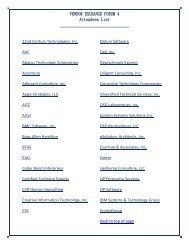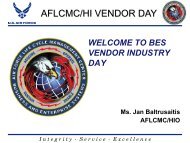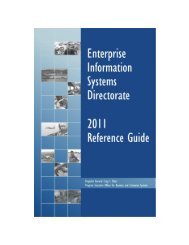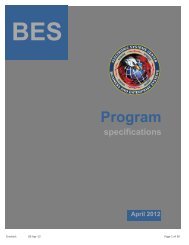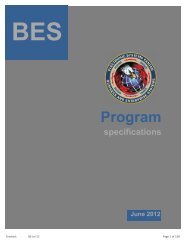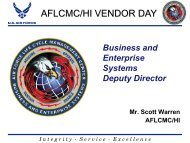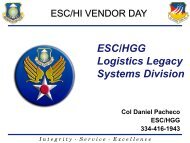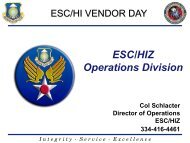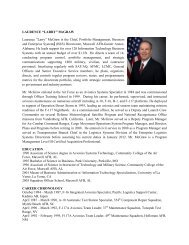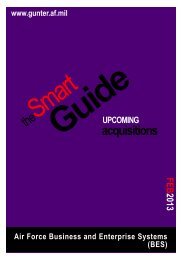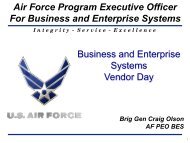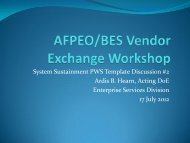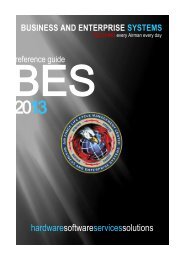Integration & Developmental Planning Discussion - Maxwell Gunter ...
Integration & Developmental Planning Discussion - Maxwell Gunter ...
Integration & Developmental Planning Discussion - Maxwell Gunter ...
You also want an ePaper? Increase the reach of your titles
YUMPU automatically turns print PDFs into web optimized ePapers that Google loves.
AFLCMC/HI VENDOR DAYBES<strong>Integration</strong> OfficeOverviewMr. David SampsonChief, <strong>Integration</strong> BranchAFLCMC/HIQII n t e g r i t y - S e r v i c e - E x c e l l e n c e
Organizational AlignmentExternal Governance(GEB, GEG, ESWG, etc.)C3I&NMr. Shofner, SESBusiness & Enterprise Systems(BES)SAF/AQDET 5Mr. Scott WarrenBES DeputyOrganizational Senior FunctionalsPEO StaffFMPM &LCLPK HR ENC. StaffSBJABusiness Sustainment DivHIBMr. NixonD: Mrs. RhodesEnterprise Services DivHICMr. HunterD: Ms. CrewsOperations DivHIZCol. Kjall GopaulD: Mrs. DavisEnterprise App & Int DivHIQCol ParkerD: Mr. OlgeatyLogistics Sustainment DivHIACol PachecoD: Mr. HulseyI n t e g r i t y - S e r v i c e - E x c e l l e n c e2
AFLCMC/HIQ Enterprise Application& <strong>Integration</strong> Division MissionMission StatementProgram Execution, <strong>Integration</strong> of the Enterprise & Advanced <strong>Planning</strong>Mission Tasks‣ Deliver DEAMS & AF-IPPS Capabilities‣ Ensure interoperability amongst ERPsand existing, legacy IT businesssystems‣ Leverage commonalities whenappropriate‣ Ensure lessons learned are capturedand used across the business ITenterprise‣ Conduct early acquisition planning inresponse to operational user needs toinitiate high-confidence business ITprogramsPlan – Integrate – ExecuteI n t e g r i t y - S e r v i c e - E x c e l l e n c e3
Enterprise Application &<strong>Integration</strong> Division (EA&ID)Colonel Brian Parker, Director 937-257-2714Mr Scott Olgeaty, Director of <strong>Integration</strong> 937-257-2714Mr Tom Davenport, Program Manager,Hanscom AFB, MA 781-225-2795Mr David Garofoli, Program Manager,WPAFB, OH 937-257-8451Mr Greg McCan, Branch Chief,WPAFB, OH 937-257-5371Mr David Sampson, Branch Chief,<strong>Gunter</strong> Annex, AL 334-416-4536I n t e g r i t y - S e r v i c e - E x c e l l e n c e4
Genesis of the<strong>Integration</strong> Branch• The <strong>Integration</strong> Branch was established to:• Address CSAF strategic and tactical objectives to:• Increase the affordability and cost effectiveness of IT Acquisition &Support• Integrate the IT side of Financial Improvement and Audit Readiness• Institutionalize lessons learned on commercial software acquisitions &implementations• Coordinate capability requirements and manage dependenciesacross PEO BES, C3I&N, and DISA• Define & implement PEO initiatives to meet AFLCMC Principles &ObjectivesI n t e g r i t y - S e r v i c e - E x c e l l e n c e5
AFLCMC GuidingPrinciples & ObjectivesPrinciples• Unity of Purpose• One integrated LCMC team…all have arole in mission success• Enterprise focus…think and act geoagnostic• Collaborate with & complement HQAFMC, SAF/AQ, other Centers• Cross portfolio, cost-effectivesolutions• Speed with Discipline• Standard, lean, tailorable processes• Predictable workflow• Expanded capacity…”unclog thesystem”Objectives• Deliver cost-effective acquisition solutions• Deliver affordable and effective productsupport• Launch high confidence sustainableprograms• Standardize & continuously improveCenter processes• Develop and place right person at righttime• Assure a safe, secure, and quality workenvironment• Trust and Confidence• Make & meet commitmentsI n t e g r i t y - S e r v i c e - E x c e l l e n c e6
BES <strong>Integration</strong>Objectives & TacticsProcess <strong>Integration</strong>• Institutionalize Standard Processes• Process Change Management• Implement IT Acquisition Reform• DoDI 5000.02, BCL, and SDDP• CMMI / ITIL Implementation• Best Practices / Lessons Learned• Standardize PEO Metrics Program<strong>Integration</strong>GovernancePortfolio <strong>Integration</strong>• Implement Common PM Solutions• Develop PEO Roadmaps• Lead FIAR Remediation Coordination• <strong>Integration</strong> Strategic Communication• Enterprise EMA / SLA Coordination• Liaison to AF Governance Bodies (ITGEG,ITGEB, SWB)• <strong>Integration</strong> Summit Management1. Increase effectiveness and efficiency of capability delivery lifecycle2. Engage and support enterprise partners throughout the lifecycle3. Deliver on promises to CSAF and other Senior leadersCommon BaselineEfficiencies & ReuseSolution & Infrastructure• PEO BES Liaison to C3I&N PEO• Common Computing Environment (CCE) andTB / IB / OB Baseline Transition Analysis• System Performance Evaluation & Optimization• Enterprise Level Security (ELS) Analysis• Common Reusable Data Services• Capability Reuse AssessmentsI n t e g r i t y - S e r v i c e - E x c e l l e n c e 7
<strong>Integration</strong> BranchMr David Sampson, Branch Chief 334-416-4536<strong>Maxwell</strong> AFB – <strong>Gunter</strong> Annex, ALMr Jeff Stephan, Section LeadWPAFB, OH 937-257-3700Ms Debra Jenkins, Section LeadWPAFB, OH 937-904-0632Major Paul Sebold, Section ChiefWPAFB, OH 937-257-0774Mr Mark Bean (<strong>Gunter</strong>)Mr Dennis Reaker (<strong>Gunter</strong>)Mr Darrel Tubbs (<strong>Gunter</strong>)Mr Corey Stager (WPAFB)[ VACANT / 2210 ] (<strong>Gunter</strong>)Mr. Mike Kometer (<strong>Gunter</strong>) - MITREMr Robert Kasprzak (WPAFB)Ms Lisa Brown-Hite (WPAFB)Ms Sadie Pitts (<strong>Gunter</strong>)Capt Aaron Beebe (WPAFB)Ms Amy Smart (WPAFB)Mr Chris Sharbaugh (WPAFB) – KTRMr Robert Baum (WPAFB) – KTRMr Jude Stanley(WPAFB)[ VACANT ] (WPAFB)[ VACANT - Capt ] (WPAFB)Mr Brad Gates (WPAFB) – MITREMr Raju Shyam (WPAFB) – KTRMr James Wiedner (WPAFB) – KTRMr Charles Destefani (WPAFB) – KTRMr Devon Tweston (WPAFB) – KTRMr Raj Jesudhason (WPAFB) – KTRMr Seth Davis (WPAFB) - KTRI n t e g r i t y - S e r v i c e - E x c e l l e n c e8
Process <strong>Integration</strong> SectionMission Statement / Key FunctionsMission:‣ Improve capability delivery efficiency and effectiveness across the BES acquisition,operations, and service missions‣ Establish, integrate, and institutionalize common standards, repeatable processes,practices, tools and persistent functions.Key Functions/Initiatives:‣ Institutionalize BES Integrated Lifecycle Process (LMP) (FY13-14 Initiative)‣ Form/facilitate the BES Process Improvement Board (PIB); implement ITAcquisition Reform‣ PEO Liaison to AFLCMC Process Improvement Teams (AFLCMC StrategicObjective #4)‣ Modernize and rebrand the BES Systems Engineering Process (SEP)‣ Metrics Standardization / Master Metrics Plan (FY13-14 Initiative)‣ Standardize PEO BES and program metrics produced for internal and externalreporting‣ Engage oversight bodies (SWG, ESWG, ITGEG, ITGEB, PfMs/PEMs, etc.) on processinitiatives8/27/2013I n t e g r i t y - S e r v i c e - E x c e l l e n c e9
Portfolio <strong>Integration</strong> SectionMission Statement / Key FunctionsMission:‣ Provide the PEO and staff with the information and tools to effectively and efficientlymanage delivery of capabilities‣ Provide cross-division facilitation and reporting of integrated capabilities and initiatives‣ Develop PEO strategies and processes for transition and integration of new initiativesinto division portfoliosKey Functions/Initiatives:‣ Lead PEO FIAR Remediation Coordination (FY13-14 Initiative)‣ Integrate PEO BES activities to support the functional owners in meeting FIARdeadlines‣ Develop PEO Roadmaps (FY13-14 Initiative)‣ Develop a series of management views to track PEO performance (situationalawareness)‣ Implement Common PEO & Program Management Solutions‣ Compliance analysis and assessments; lessons learned/best practices; toolsstandardization‣ Define and implement common program lifecycle management enabling solutions(architecture, scheduling, requirements, testing, configuration management,service requests)8/27/2013I n t e g r i t y - S e r v i c e - E x c e l l e n c e10
FIAR Roadmap• Description: The first priority in obtainingFinancial Improvement and Audit Readiness(FIAR) compliance is obtaining General FundsStatement of Budgetary Resources (GF-SBR)Federal Information System Controls AuditManual (FISCAM) audit readiness. Thisroadmap shows each BES system’s progresstoward meeting the SAF/FMP providedsuspense date.• Objective: Provides a consolidated view of theBES FISCAM audit readiness for reporting atthe PEO Staff Meeting and for maintainingsynchronization with SAF/FMP, the customers,and other stakeholders• Frequency of Reporting: MonthlyI n t e g r i t y - S e r v i c e - E x c e l l e n c e11
Capability DeliveryToday• Description: Identifies whencapability releases are planned orhave been delivered to operationalcustomers (for the current FY)Planned vs. Actual // As of: 12 Jun 2013HIA System Oct-12 Nov-12 Dec-12 Jan-13 Feb-13 Mar-13 Apr-13 May-13 Jun-13 Jul-13 Aug-13 Sep-13ATOSDMLSDMSIIMDS EMOCETIMSIMDS CDBIMDS MSATIMDS PAMSIMDS TBAJCALSJEDMICSPLMSREMISAFEMSCMOSCSWS-DEILS-SIMCSLMDBMP&EPRPSRMSSCSWSMIS• Objective: Provides situationalawareness of planned and actualcapability releases and reportssuccess rates for each BESDivision and the BES DirectorateI n t e g r i t y - S e r v i c e - E x c e l l e n c e12
Section 508 Compliance• Description: Section 508 of theRehabilitation Act (29 U.S.C.794d), as amended by theWorkforce Investment Act of1998 (P.L. 105-220), requiresfederal agencies to make use ofelectronic and IT accessible topeople with disabilities. Unlessexempted or granted a waiver,BES systems must comply withthe requirements of Section 508As of: 28 May 13• Objective: Provides situationalawareness and Section 508compliance status for BESDirectorate programsI n t e g r i t y - S e r v i c e - E x c e l l e n c e13
C&A Status Snapshot• Description: Information Assurance(IA) is the practice of managinginformation-related risks. IA seeks toprotect and defend information andinformation systems by ensuringconfidentiality, integrity,authentication, availability, and nonrepudiation70605040302010066As of: 04 June 1313842ATO IATO Exempt Expired No Answer• Objective: Provide a comprehensiveview to the PEO and BES leadershipon the IA compliance status ofprograms within the BES portfolioI n t e g r i t y - S e r v i c e - E x c e l l e n c e14
Solution/Infrastructure <strong>Integration</strong> SectionMission StatementsMission:‣ Optimize how programs establish and use technical environments and supportinginfrastructures‣ Partner with infrastructure providers to effectively deliver effective application andsupporting infrastructure solutions‣ Foster reuse and interoperability of technical infrastructures to meet warfighterneeds.‣ Assist programs in meeting numerous compliance items and achieve efficiencies byconsolidating and managing a quality application and information architecture‣ Capitalize on architecture to jointly identify opportunities for integration, reuse,consolidation, interoperability, and continuity8/27/2013I n t e g r i t y - S e r v i c e - E x c e l l e n c e15
Solution/Infrastructure <strong>Integration</strong> SectionKey Functions‣ PEO BES Liaison to PEO C3I&N (FY13-14 Initiative)‣ Common Computing Environment (CCE), Commoditized Infrastructure, Common Tools‣ TB / IB / OB Baseline Requirements <strong>Integration</strong> & Transition <strong>Planning</strong> (FY13-14 Initiative)‣ Consolidate PEO Requirements and align program needs/reuse‣ INFORM PROGRAMS! OUTREACH‣ Common Reusable Data Services (FY13-14 Initiative)‣ Partner with functional communities to an establish reusable data services‣ Facilitate information solutions through common Master and Reference data integration‣ Capability Reuse Assessments‣ Partner with functional/technical communities and programs to drive common solutions tocapability needs/requirements‣ System Performance Evaluation & Optimization (Development / Test / Production) (FY14 Initiative)‣ Expand the benefits of the DISA Boundary Simplification effort to other PEO BES applications‣ Develop common testing methods and procedures for End-to-End (cross-program/organization) testintegration (FIAR, ERPs, modernization efforts, etc.)‣ Foster automated test capabilities PEO-wide for compliance, audits, regression testing, etc.‣ PEO Liaison to AF/DoD DT&E and OT&E Organizations‣ Technology Assessment / Market Research of product line evolution and emerging IT solutions8/27/2013I n t e g r i t y - S e r v i c e - E x c e l l e n c e16
I n t e g r i t y - S e r v i c e - E x c e l l e n c e 17
AFLCMC/HI VENDOR DAYDevelopment<strong>Planning</strong>Support within BCL & SDDPMr. Greg McCanChief, Dev <strong>Planning</strong> BranchAFLCMC/HIQDI n t e g r i t y - S e r v i c e - E x c e l l e n c e
Agenda• Development <strong>Planning</strong> Overview• DP Activities within BCL• DP Activities within SDDP (SDDP Introduction)• DP Focus Areas• Industry Partnership• DP TakeawaysI n t e g r i t y - S e r v i c e - E x c e l l e n c e19
Tenets of Development<strong>Planning</strong>Bridge warfighter capability needsEvaluate system-of-systems conceptsIncorporate life cycle planningUnderstand technology gapsIdentify and assess risksStart high confidence programsRequirementsTechnologyDP StandardProcessesLife CycleManagement20I n t e g r i t y - S e r v i c e - E x c e l l e n c e20
Development <strong>Planning</strong> Scope:Defense Business Systems (DBS)FunctionalSponsor• Develops CapabilityNeed• Develops BPR• Conducts AoAs• Provides SDDP products• Bounds End UserRequirementDevelopment<strong>Planning</strong>• Market Research• Acquisition & ContractStrategy• Technical Requirements• Integrated Master Schedule• Contract Actions (e.g. RFP)• System Engineering &Architecture Development• Cost Estimates• Risk DriversPMOs• Acquires technologiesto meet End User needs• Develops acquisitionstrategies• Develops cost estimates• Conducts contractactions• Executes testing• Deploys materielsolutionITLCAchieving AQ Process Improvement And Detailed Requirements DefinitionI n t e g r i t y - S e r v i c e - E x c e l l e n c e21
Development <strong>Planning</strong> is aRequirement• DTM-10-017, Development <strong>Planning</strong> to Inform MDD Reviews and SupportAoAs, OPR-USD(AT&L) – Updated Jan 2013• Establishes policy, responsibilities, and guidance in support of defense acquisition• AFI 63-101 Acquisition and Sustainment Life Cycle Management, (OPR -SAF/AQX) – Updated Aug 2011• Defines scope of DP:• A materiel contribution to AF or AF-led capability planning• Greatest leverage to entire product/system life cycle prior to the MDD• Collaboratively identifies and develops concepts (prospective materielsolutions) in response to operational capability needs• Early acquisition involvement to ensure initiation of high-confidence programs• Additional DP guidance, roles & responsibilities, and policy provided in:• AFI 63-1201 “Life Cycle Systems Engineering” (OPR - SAF/AQR)• AFI 10-601 Operational Capability Requirements Development , (OPR -AF/A5R)AFLCMC/HI dedicated to DP For Defense Business System (DBS)I n t e g r i t y - S e r v i c e - E x c e l l e n c e22
Business IT DP ServicesWork Breakdown StructureDirect Capability Initiative SupportPersistent CapabilityMDD SupportSolutionIdentificationMilestone SupportDBS SolutionKnowledgeIndustry“Sandbox”BCL Process navigationMarket ResearchAcquisition Strategy /Contract MgmtKnowledge ExpansionCOTS ConceptDevelopmentSDDP-BCL alignmentWBS / IMS /Manpower AssessOEP CertificationMaterial SolutionAnalysisOperationalFeasibilityFunctional ROMAssessmentCost EstimationFinancial AnalysisIT Acquisition ProcessImprovementC3NI Trading PartnerMDD PackageCoordinationCOA Analysis / AOAMS Package Coord /Risk Mgmt / EVMCapability Need TechAssessmentPreferred Solution Fit-Gap AnalysisSystem Arch / Trade-SpaceBPR/BEA AssessmentFunctional-SystemReqmnt TransitionBPR/BEA Assessment• Problem Statement• AOA Study Plan• M-Imp Plan• System Reqmnt Doc• RFP Package• Program Charter• Business Case• Supporting AQ docs• MS Briefings• Newsletters• Whitepapers• Articles• Blog• IT Benchmarking• Feasibility AnalysesI n t e g r i t y - S e r v i c e - E x c e l l e n c e23
DP / SDDP / BCL Touch PointsDEVELOPMENT PLANNINGProgram Office AcquiredSupportSustainment AcquiredSupportABCBCLPSBCL Business CaseSections 1-3 BCL Business Case Sections 4-6AOAStudyPlanBCPCPreparing for Investment Decision PointsUpdate as requiredLaunch High Confidence ProgramsIdentifyCapabilityRequirementsDefine MissionProcesses toDeliverCapabilityDefineMaterielSolutionPlanMaterielSolutionConfigureMaterielSolution(COTS)PlanResolutionto FIT/GAPAnalysisDevelopMaterielSolution toResolve GapsDeploySDDPM-IPBRMContextualModelSRMIMSPRMDOTMLPFIPCOACriteriaFunctional Acquired SupportDRMNeeds Translating RequirementsDevelopmentTestDevelopmentTestOperationalTestPRM – Performance Reference ModelBRM – Business Reference ModelIP – Implementation PlanSRM – Services Reference ModelDRM – Data Reference ModelCOA – Course of Action24
BCL Phase DescriptionsBCD & IM Overview• Business Capability Definition (BCD):• Analyze a perceived business need (i.e. Problem Statement)• Determine root causes• Identify “what good looks like” with High-Level Objectives (HLOs) andBusiness Outcomes (BOs)• Emphasis on transforming business processes in DOTMLPF-P to determine ifa materiel solution need exists• Covers entire scope of problem/business capability need• Investment Management (IM):• Conduct Materiel Solution Analysis (MSA) against the HLOs and BOs• Define and plan an acquisition program to deliver the M-solutionto meet the business need• Develop Business Case, ProgramCharter, & MS A artifacts• Up to 12 months, regardless of ACAT• Covers entire scope of M-solutionI n t e g r i t y - S e r v i c e - E x c e l l e n c e25
Service Development & DeliveryProcess (SDDP) - Overview• Focused on delivering IT capability needs• Guidance in Draft AFMAN 90-XXX, updated June 2013• Authored by SAF/US(M) – AF Deputy Chief Management Officer (AF DCMO)• Designed for all ACAT-level IT acquisition programs• Six step information-gathering process that supports other overarchingIT acquisition methodologies, including:• Business Capability Lifecycle (BCL)• Joint Capability Integrated Development System (JCIDS)• Defense Acquisition System (DAS)• <strong>Planning</strong>, Programming, Budgeting, and Execution (PPBE)• Assumes common data and infrastructure exist• Does include contract management or specifics on the variouscompliance requirements for an IT acquisitionFit/Gap With Other Methodologies TBDI n t e g r i t y - S e r v i c e - E x c e l l e n c e26
• Uses several reference modelsand implementation plansto document progress• Emphasizes End Userinvolvement andFunctional Sponsor(FS) controlthroughoutprocessSDDP Details6-Step Process456Capability DeliveredDeploy Capability and MaintainPerformanceImplement (initial delivery) of M-solution (IMS,deployable components)Deliver OutcomesPrepare to deploy the Capability (Tested buildpackage)NeedIdentified23Define Capability Requirements & Materiel Solution (SRM, DRM,contextual Model, M-implementation plan)Define the processes (BPR, Information assets, DOTMLPF ImplementationPlan (BRM))1Identify problem statement (Needs, outcomes, measures, and required capabilities(PRM))I n t e g r i t y - S e r v i c e - E x c e l l e n c e27
SDDP DetailsMajor Artifacts (1 of 2)• Performance Reference Model (PRM):• Documents capability need• Framework to measure performance of major IT initiatives• Business Reference Model (BRM):• Function-driven framework that describes areas of businessand the sub-functions performed• Contains “As-Is” and “To-Be” business process flows• DOTMLPF-P Implementation Plan (D-IP):• Describes DOTMLPF-P changes necessary to meet “To-Be”capability needs as described in the BRMI n t e g r i t y - S e r v i c e - E x c e l l e n c e28
SDDP DetailsMajor Artifacts (2 of 2)• Service Reference Model (SRM):• Description of functions and services to be delivered by themateriel solution• Data Reference Model (DRM):• Framework used to promote the common identification, useand appropriate sharing of data/information by the “To-Be”materiel solution• Materiel Implementation Plan (M-IP):• Overarching plan for delivering the determined materielsolution• Similar to BCL Business Case• Includes DOT_LPF-P Work Plans to enable the M-solutionI n t e g r i t y - S e r v i c e - E x c e l l e n c e29
MDD BCL-SDDP Artifact &Phase AlignmentStepBCLSDDP Artifacts1 PRM• BRM2 • DOTMLPF-P ImpPlan (D-IP)• Contextual Model3• COA CriteriaSupports In BCLDocumentation OEP Process MDD• Problem Statement• BPR Assessment• BEA Assertion**Needed prior to obligation of funds• OEP Development• E-SWG• PCA Approval Memo• DBSMC Cert*Business Capability Definition (BCD)• IRB Approval of ProblemStatement• AoA Study Guidance (SG)• AoA Study Plan (SP)• DBSMC CertMDD Outcomes• MDA identified• Material solution decisionconfirmed• ACAT designation• ACQ process entry• ADM (decisions and funds)MDDInvestmentManagement (IM)High-levelProcess FlowIRB/DBCVia ComponentAoASG60 Days fromMDD ForMAIS/MDAPProblemStatementPCAMemoDBSMCAoASPDABMDDADMPRMBRMDIPBPRBEAOEPE-SWGCOACriteriaNeeded fornew obligationsDBSMCCertBlue documents represent BCL deliverables for MDDSDDP Step 1 Step 2 Step 3**Not representative timelinesI n t e g r i t y - S e r v i c e - E x c e l l e n c e30
MS A BCL-SDDP Artifact &Phase AlignmentStep34 IMSSDDP Artifacts• COA Analysis• SRM• DRM• M-Implementation Plan (M-IP)• DOT_LPF-P Work PlansMDDSupports In BCLDocumentation OEP Process MS A• Materiel SolnAnalysis• Business Case• BPR Update• BEA Assertion*• Service CostEstimate (SCP)*Needed prior to obligation of funds• OEPDevelopment• E-SWG• PCA ApprovalMemo• DBSMC Cert*• Business Case• Program Charter• BPR Assessment• BEA Assertion• Title 40/CCA Cert• MS A Package• DBSMC CertMS A Outcomes• Approved Business Case andProgram Charter• MDA authorization to conductPrototyping in “operationallyrelevant environment”• ADM (decisions and funds)BCL BCD Investment Management (IM) PrototypingMS AHigh-levelProcess FlowCOAs SRMMatDRMSolnAnalysisMDDADMWinningCOAMDDM-IPIMSCCACertSCPBusinessCaseProgramCharterACQDocsIRB/DBCMS APackageDABDBSMCMS AADMBPRBEAOEPE-SWGPCAMemoDBSMCCertSDDP Step 3 Step 4**Not representative timelinesBlue documents represent BCL deliverables for MS AI n t e g r i t y - S e r v i c e - E x c e l l e n c e31
RFIs and Bidder’s Library• Detailed Information based on methodology:• SDDP results in multiple artifacts, content should be familiarto industry analysts, engineers, and PMs• PRM, BRM, SRM, DRM, & M-Imp provide evolving referencesto solution• SRD will provide functional and technical requirements alongwith traceability to process maps• Business Case will provide justification for the recommendedapproach to solving a defined problem• Program Charter will provide the manner in which theprogram will be managed – will continue to evolve includingimplementer’s plansI n t e g r i t y - S e r v i c e - E x c e l l e n c e32
• Step 1:DP Within SDDPActivity and Artifact Support (1 of 2)• Capability assessment of PRM• Ensure performance attributes are measurable and crosscutting• Determine how PRM info can support the BCL ProblemStatement• Step 2:• BPR consultation and review of BRM• Root Cause Analysis review• Rough-Order Magnitude (ROM) cost estimates for D-IP• Determine how BRM, and D-IP info can support the BCLProblem StatementI n t e g r i t y - S e r v i c e - E x c e l l e n c e33
• Step 3:DP Within SDDPActivity and Artifact Support (2 of 2)• Review Contextual Model• Ensure COA analysis informs AIP, AoA and Preferred MaterielSolution Analysis• Ensure M-IP informs the artifacts of the MS A package• Ensure that system requirements can be derived from theSRM and DRM to support requirement evolution and developthe SRD• Step 4:• Support Program Management team• Develop Integrated Master Schedule (IMS)• Support development of the RFP package• Transition BUR into SRDI n t e g r i t y - S e r v i c e - E x c e l l e n c e34
DP ObjectiveDirect Capability Initiative Support• DP WBS 1.0 “Launch high-confidence programs”• Focus Area – Early Acquisition & SE support:• Consult on BCL/SDDP artifact deliverables• Provide rigor in BEA & BPR assessments• Develop ROMs for “To-Be” DOTMLPF-P impacts• Results – MDD and MS A• Focus Area – Early Concept Demonstration:• Conduct Fit/Gap Analysis• Provide operational and infrastructure feasibility assessment• Results – Well-defined Bounded User Requirements (BURs)• Focus Area – Requirement Evolution:• Transition BURs into System Requirements Documents (SRD)• Results – RFP release, FFP T/Os, & shorter vendorevaluations w/LPTA criteriaI n t e g r i t y - S e r v i c e - E x c e l l e n c e35
Focus Area #1Early Acquisition and SE Support• Ensure SDDP content supports BCL artifact requirements forMDD and MS A• Major activities include but are not limited to:• Support development of all BCL and SDDP work products• Identify cross-cutting metrics (from “As-Is” to “To-Be”)• Capability mapping to process flows• Multiple ROMs and cost estimates• Financial benefit analysis• Support for RFP development• Contract strategy actions• Requirements traceabilityI n t e g r i t y - S e r v i c e - E x c e l l e n c e36
Focus Area #2Early Concept DemonstrationPersistent CapabilityLong term persistentcapability to be leveragedduring IM phaseDBS SolutionKnowledgeKnowledge ExpansionMaterial SolutionAnalysisIT Acquisition ProcessImprovement• Newsletters• Whitepapers• Articles• BlogIndustry“Sandbox”COTS ConceptDevelopmentOperationalFeasibilityC3NI Trading Partner• IT Benchmarking• Feasibility AnalysesI n t e g r i t y - S e r v i c e - E x c e l l e n c e37
Focus Area #3Requirement Evolution• Transition Bounded User Requirements into SystemRequirements Document for RFP release• Purpose is to:• Ensure RFP requirements are easily understoodby Government and vendors• Require vendors be fully accountable fordelivering prescribed capability• Reduce vendor evaluation durations• Reduce probability of protest or reduce protestinvestigation• May leverage/require Early Concept Development• Future DP support to include hands-on softwareconfiguration within “sand-box”IdentifyCapabilityNeedDetermineMaterielSolutionAnalyzeBounded UserRequirementConductFit/Gap &ConceptDevelopmentDevelopSystemRequirementsDocumentRequest ForProposalRequirement Evolution ProcessI n t e g r i t y - S e r v i c e - E x c e l l e n c e38
DP Focus Area ApplicationActivity Model* During IM PhaseMDDASPsMS A/BBCDInvestment Management (12 Months)PrototypingDP ActivitiesBCL ActivitiesIn-house DPwith “mixed”vendor supportConductAoAPreferredAlternativeMateriel Solution AnalysisPreferredSolutionAnalysisPreferredSolutionCapability DemoMDD Support Solution Identification Milestone SupportPM AssignedJ&A Sole-SourceJustification• M-solution BPR• Develop POs• ID DOT_LPF-PImpacts• ID RisksContinuous Market ResearchContinuous Fit/Gap AnalysisEPOC 1Enterprise Proof Of ConceptsEPOC 2EPOC nRequirements EvolutionDefine ProgramFinancialAnalysisDevelopCONOPSDetermineCapabilityDeliverySRD 1 RFP 1SRR 1Plan ProgramDevelop MS A/B Package• Acquisition Strategy• SE Plan• Program• Test PlanCharter• IA Strategy• Business• Info Support PlanCase• Program Protection Plan• Lifecycle Sustainment Plan• Acquisition Program BaselineSFR 1 – PMOTransitionReleaseRFPConductPrototypingA-IPMDDADMAoAReportPOEMS APackageMS AADMSDDP ActivitiesContextual COA-AModel CriteriaConduct COAAnalysisDevelop M-IPDevelopBURBUR• SRM• DRMM-IPDevelopIMSStep 3 Step 4IMS*Activity Timelines not exactExecuteIMSI n t e g r i t y - S e r v i c e - E x c e l l e n c e39
DP / SDDP / BCL Touch PointsDEVELOPMENT PLANNINGProgram Office AcquiredSupportSustainment AcquiredSupportABCBCLPSBCL Business CaseSections 1-3 BCL Business Case Sections 4-6AOAStudyPlanBCPCPreparing for Investment Decision PointsUpdate as requiredLaunch High Confidence ProgramsIdentifyCapabilityRequirementsDefine MissionProcesses toDeliverCapabilityDefineMaterielSolutionPlanMaterielSolutionConfigureMaterielSolution(COTS)PlanResolutionto FIT/GAPAnalysisDevelopMaterielSolution toResolve GapsDeploySDDPM-IPBRMContextualModelSRMIMSPRMDOTMLPFIPCOACriteriaFunctional Acquired SupportDRMNeeds Translating RequirementsDevelopmentTestDevelopmentTestOperationalTestPRM – Performance Reference ModelBRM – Business Reference ModelIP – Implementation PlanSRM – Services Reference ModelDRM – Data Reference ModelCOA – Course of Action40
Industry PartnershipHow you can help?• Focus Area: Early Acquisition & System Engineering support• Ramp up on SDDP as a requirements development methodology• Bring benchmark and recognition of accomplishments BPR results• Focus Area: Early Concept Demonstration• Support “fly-off” ready material/product solutions during COA/AOA• Minimize footprint required to implement & configure product• Bring responses/proposals to SBIRs needed to establish “art of thepossible”• Focus Area: Requirement Evolution & Capability Evolution• Help pursue smaller initiatives• Formulate strong functional partnerships• Support a segment of the implementation based on your corecompetencyI n t e g r i t y - S e r v i c e - E x c e l l e n c e41
Takeaways• DP is active during BCL phases BCD & IM and SDDP Steps 1-4• DP activity stops at MS A• DP has 3 primary focus areas during these phases/steps• Early Acquisition and SE Support• Early Concept Demonstration• Requirement Evolution• DP is new to IT acquisition• Proven capability and value on weapon systems• New activity for Defense Business Systems• DP is not a PMOI n t e g r i t y - S e r v i c e - E x c e l l e n c e42




